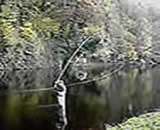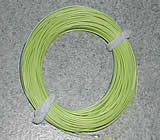 |
|||||||||||
Casting Faults & Cures
|
|||||||
Why does it all go wrong? |
|||||||
In this section, it is my intention to point out some of the most common faults that can occur during casting. These faults will not only spoil your enjoyment of the sport, but can also be the difference between a successful, or unsuccessful day. They will certainly influence your presentation, cause a disturbance on the water surface, and have a bearing on your success rate, but in most cases will also restrict the distance your cast will travel where distance is one of your objectives.
Roll casting tips
You can see from the picture above, that as the forward travelling loop (near the rod tip) begins to form as you are performing the roll cast, that the fly line following on behind is about to move in an upward direction. This is because the rod tip has been projected upwards by your thumb, allowing the line to unroll above the water on the delivery. This also allows for a better presentation of the fly, and more distance where required. Never start this, or any other cast, from a high position as the delivery will always travel downwards. (start low aim high)
____________
The picture shown below is somewhat different, this is because the cast has been started from a high position and therefore the thumb has immediately travelled down causing the rod tip to also travel down and the line to follow. The end product will inevitably be a bad turnover resulting in the leader and fly crashing into the water and spoiling the forward cast. This will not only result in an untidy presentation, but also prevent you attaining distance from your roll cast if required, and more importantly scare off your quarry. (Remember; height at the front will assist you with distance and turnover) You may have been told that the Roll Cast can be executed by using a short progressive downward stroke. This is also true, but (in my opinion) from a beginners point of view, this requires much more control, especially when trying to keep the rod tip high at the point of delivery. So I would suggest, that at least for now, you follow the above technique, but during a casting lesson, I will cover both if required.
There are scenarios where the casting arc needs to be tilted forward, for casting into a wind, or into tight areas. I will cover this during you lesson.
Rod Joints.
Although the following is not a fault as such, if neglected, it can often cause a major problem when Spey Casting. The problem I am referring to, is that of taping the joints of your salmon fly rod prior to fishing. There are differing views on this subject, some say it does not matter and others say it does. My personal opinion, is that anywhere there is a joint, there is potentially a weak link. Combine this with the fact that the rod will then be twisted and turned (in all directions) during the many Spey Casting techniques you will use, there is a good chance that the joints will work loose and you will be treated to an almighty crack when delivery one of your casts. This can be avoided with a little consideration.
To overcome this potential problem, secure the joints of your Salmon fly rod using tape. Amalgamating tape (in my opinion) is a good choice because as it stretches it grips and sticks to itself, as apposed to the rod, and at the same time creates a good secure joint, where as electrical tape, which I have used from time to time, has on rare occasions been known to cause problems with badly varnished rods as it does stick hard to the blank. Before taping your joints, make sure that you have not attached the fly reel first, as this will prevent the blank from turning freely as you do so. Apply the tape about 1 inch (25mm) above the joint at a downward angle of about 45 degrees, then turn the rod blank so that as the tape is wound around the blank in touching turns, it travels in a downward spiraling direction. keep turning until the tape travels down to about 1 inch below the joint and then, because it is quite flexible, you can stretch it slightly so that it now faces 45 degrees up the way. Carry on turning the blank, so all you have done is simply reversed the process, taking the tape in touching turns back to the start position once again. Securing your joints before casting will prevent them from twisting in both directions. If you prefer electrical tape, when you have returned your tape to the start position, cut the tape from the roll and fold over a very small corner of the tape before sticking it down. You now have a small tag, (see picture) so you can later remove the tape more easily, especially if you are loosing the light at the end of the day. It is important not to make this fold too big, as it can interfere with the fly line during casting. ____________ |
Spey Casting
These technique are not restricted to double handed Salmon rods only, as they can also be a great asset when casting with your trout rod. They are all casts that I personally use on a regular basis when fishing with both rods, and are very useful casts when fishing for Sea trout fishing at night as the fly is always delivered from a safe position on the water and therefore doesn't whiz past your ear when casting. This certainly gives me great peace of mind during the twilight hours.
At this point, I hear many of you saying to yourselves "ah yes, but this is a cast that makes too much noise when touching down on the water, and sometimes makes a slurp when leaving the water again on the forward delivery". If this is the case, then you have a fault, or faults during the execution of your cast. This can be easily remedied by way of a tuition session, and I would be more than happy to help. Fly rods are often referred to as both levers and springs and to load them efficiently you need to move them smoothly and progressively in the direction you want them to go, this must be done by applying Let's face it, you don't see those beach casting guys whacking their casts too fast too early, Why? because they would end up with a birds nest of line on their multiplier reels and possibly a heavy weight around their necks. All anglers need a weight to load the rod correctly, these weights simply take different forms and can be dependant upon the stiffness, or action of the rod being used. Coarse and Sea anglers use compact casting weights where as fly fishers require a similar weight but need it stretched out over a longer distance allowing them to deliver a delicate presentation when needed. This weight comes in the form of a fly line.
|
||||||
home | about me | casting tuition | faults & cures | courses | angling holidays | accommodation | Links | Contact Us | Site Map
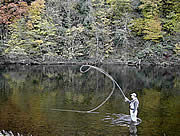
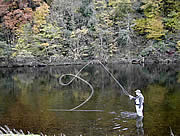
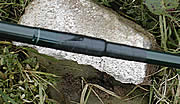
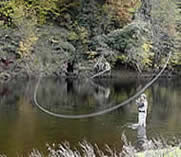
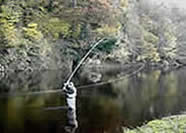
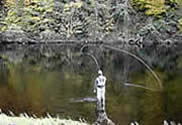
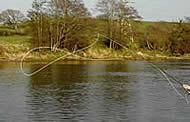 constant acceleration throughout the cast, with the fastest part of the cast being just prior to the stop. However this can all be quite confusing when first starting out in fly fishing. So just keep it simple and say to yourself, "if I start my cast by applying speed too early, I will then find it very difficult to increase the speed throughout the cast, inevitably ending up with a tailing loop as shown in the picture. This will cause your rod tip and ultimately your fly line (as it will follow the path of your rod tip) to take a concave path, (i.e. a dip) as apposed to a straight line path, causing the fly to catch the leader and create what is often called a wind knot. It is not the wind that causes this common fault believe me!
constant acceleration throughout the cast, with the fastest part of the cast being just prior to the stop. However this can all be quite confusing when first starting out in fly fishing. So just keep it simple and say to yourself, "if I start my cast by applying speed too early, I will then find it very difficult to increase the speed throughout the cast, inevitably ending up with a tailing loop as shown in the picture. This will cause your rod tip and ultimately your fly line (as it will follow the path of your rod tip) to take a concave path, (i.e. a dip) as apposed to a straight line path, causing the fly to catch the leader and create what is often called a wind knot. It is not the wind that causes this common fault believe me! 